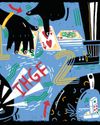
Many animals find their way across continents or even around the world every year. The homing pigeon will fly up to 700 miles (1,127 km) in a single day to return to its roost. How does it figure out how to get there? How does the loggerhead turtle navigate 7,500 miles (12,070 km) across the Pacific Ocean? We humans sometimes need GPS just to get to dance class! The answer is migrating animals have a variety of super skills. Sometimes they use the same basic senses we do to get around, other times they sense things our bodies can't detect.
Written in the Stars
In a long-distance animal migration, there are no sign posts or roads to follow, but there's always the Sun. The monarch butterfly uses the Sun to navigate from the northern United States to central Mexico. The Sun changes position in the sky throughout the day, so the monarch adjusts its calculation of what's south for different times of day. "It is really an incredible feat that these little butterflies are able to make that amazing long-distance migration," University of Chicago ecologist Marcus Kronforst has said.
If you travel at night, you can't rely on the Sun. Harbor seals navigate by the stars when they search for food at night. In one experiment, the animals were able to follow a specific star in a planetarium "sky." When nocturnal dung beetles want to roll their pile of poop away to a safe spot, their compound eyes can't make out individual stars. But they can use the light of the Moon to find their way.
Animal Magnetism
هذه القصة مأخوذة من طبعة March 2023 من Muse Science Magazine for Kids.
ابدأ النسخة التجريبية المجانية من Magzter GOLD لمدة 7 أيام للوصول إلى آلاف القصص المتميزة المنسقة وأكثر من 9,000 مجلة وصحيفة.
بالفعل مشترك ? تسجيل الدخول
هذه القصة مأخوذة من طبعة March 2023 من Muse Science Magazine for Kids.
ابدأ النسخة التجريبية المجانية من Magzter GOLD لمدة 7 أيام للوصول إلى آلاف القصص المتميزة المنسقة وأكثر من 9,000 مجلة وصحيفة.
بالفعل مشترك? تسجيل الدخول

HOUSE OF CARDS
TRY THE PERFECT EXPERIMENT—AND THEN REFLECT ON HOW IT WENT.

ACCIDENTALLY Delicious
Have you ever been really hungry, but there wasn't much to eat in your kitchen? Did you throw together a bunch of stuff you had on hand and were pleasantly surprised when it tasted good?

IS YOUR SOCIAL MEDIA FEED TOO PERFECT?
EVERYONE'S LIFE CAN APPEAR PERFECT ON SOCIAL MEDIA. On YouTube, Instagram, Snapchat, and similar apps, people tend to share their happiest, most picturesque moments. They carefully compose any text to get the message just right. They use filters and enhancements to glam up images and videos. The app sorts the posts with the most likes and comments to the top. The end result? All you see of others' lives is the best of the best.

Art ALERT!
THE CASE OF THE MASTERPIECE THAT WASN'T

MARYAM ZARINGHALAM
SCIENCE POLICY FELLOW AND WRITER

Lost Cat Treks More Than 800 Miles to Get Home
Rayne Beau (pronounced RANE-BO, as in \"rainbow\") is a two-year-old Siamese cat.

EASY AS ABC
But in number theory, well, it's complicated.

That Wanaka Tree Gets a Companion
\"THAT WANAKA TREE,\" AS IT'S CALLED, IS A FAMOUS WILLOW TREE THAT GROWS OUT OF LAKE WANAKA ON THE SOUTH ISLAND OF NEW ZEALAND.

Two College Students Devise Smart Glasses That Can ID People
YOU'RE WAITING FOR THE SUBWAY WITH A COUPLE OF YOUR FRIENDS.

Two Comb Jellies Can Fuse Their Bodies Together to Become One
COMB JELLIES ARE GELATIN-LIKE AND MOSTLY SEETHROUGH INVERTEBRATES, OR ANIMALS WITHOUT A BACKBONE, THAT FLOAT IN THE OCEAN NEAR SHORE.